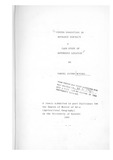| dc.description.abstract | This thesis is about small farm sector coffee production in Hatungulu location of Machakos District, Kenya. Until about 1935 coffee growing in Kenya was by law restricted to the large farms owned by Europeans settlers and the Africans were not allowed to grow it. After 1935, a few "selected" African farmers in Meru, Embu and Kisii Districts were "allowed" to grow restricted acreages of coffee on a trial basis. It was only after the Swynnerton Plan which was launched in 1954 that coffee was introduced in "African Land Areas" in relatively faster and greater scale than ever before. In recent years, the small farm sector has outstripped the estate sector in terms of hectarage under coffee and total production. To-day over 50 percent of the Kenya coffee intended for the export
narket comes from the small farm sector. The average productivity per hectare for this sector is generally lower than the estate sector, implying that there are constraints or inefficiencies, which consistently keep the yields low. In case of Machakos District, however, the productivity per hectare of the small farm sector is slightly higher than the estate sector, indicating that there is still a potential for the small scale sector, indicating that there is still a potential for the small scale farmers to increase their yields in
similar situations. This should be possible given more aqricultural inputs, effort and efficiency. It would thus enable the small farm sector to make a significant contribution to Kenya's export earnings as well as raising both the farm incomes and living standards of the rural population. This study investigates the main physical, biological and socio-economic factors influencing small farm coffee production in Matungulu location, an area
of high ecological potential, consisting almost exclusively of small scale farmers. The study has revealed that the success of coffee production depends on the understanding of certain agronomic practices, such as the importance of diseases, pests and weed
control, soil quality maintainance, the availability of labour and workinq capital.
The results of the study also reveal that a poor correlation exists between coffee yields and physical parameters. Conversely, a significant correlation between yields and socio-economic parameters is established. A step-wise multiple regression model
employed_in the study yielded the following results: First, both Income and Investment accounted for 73.1 percent of the variation in coffee yields in 1978. Secondly, both variables explained 76.1 percent of the differences in yields in 1979. On the basis of the study, it was concluded that most of the variation in coffee yields are attributed to socio-economic rather than physical variables. The socio-economic factors exercising constraints on coffee production include inadequate agronomic practices, poor extension services, lack of credit for investment, labour shortages at critical times, and a poor transportation network. tEven then, the study reveals that the small scale
coffee farmers in the Matungulu area are comparatively more prosperous than their counter parts in the non-coffee growing parts of Machakos District. Even though the benefits from the cash-crop economy boosted by coffee are obvious in
the study area, and indeed, the highland zone of Machakos District, the widespread displacement of food-crops by coffee has led to food shortages in the district. This has
given rise to frequent famines and increased vulnerability of the local population. In view of this problem, it is recommended that the small scale farmers in the study area
should be encouraged to produce adeauate food alongside their cash crops, to feed their families. This would bring about greater self-sufficiency as far as food production
is concerned and reduce its dependence on variations within the environment as well as the fluctuations in the international coffee prices. | en |

